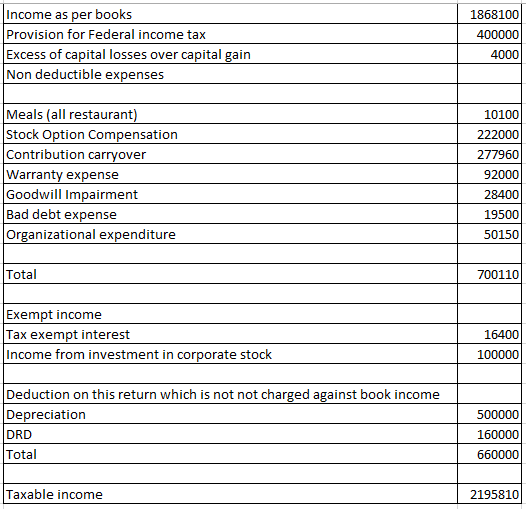a. Compute XYZ's taxable income. Taxable income
Chapter1: Financial Statements And Business Decisions
Section: Chapter Questions
Problem 1Q
Related questions
Question

Transcribed Image Text:ome taxe
Estimated tax information:
XYZ made four equal estimated tax payments totaling $433,000 ($110,000 per quarter). For purposes of
estimated tax liabilities, assume XYZ was in existence in 2020 and that in 2020 it reported a tax liability of
$612,000. During 2021, XYZ determined its taxable income at the end of each of the four quarters as
follows:
Quarter-end
First
Second
Third
Cumulative
taxable income
(loss)
$ 455,000
$ 1,155,000
$ 1,510,000
Finally, assume that XYZ is not a large corporation for purposes of estimated tax calculations. (Do not round
intermediate calculations. Round your answers to the nearest dollar amount.)
Comprehensive Problem 05-65 Part a (Algo)
a. Compute XYZ's taxable income.
Taxable income
![Comprehensive Problem 05-65 (LO 05-1, LO 05-2, LO 05-3) (Algo)
[The following information applies to the questions displayed below.]
XYZ is a calendar-year corporation that began business on January 1, 2021. For the year, it reported the
following information in its current-year audited income statement. Notes with important tax information are
provided below. Use Exhibit 16-6.
XYZ corporation Income statement For current
Book Income
$
42,200,000
(28,485,000)
$
13,715,000
year
Revenue from sales
Cost of Goods Sold
Gross profit
Other income:
Income from investment in corporate stock
300,0001
28,8002
(4,000)
Interest income
Capital gains (losses)
Gain or loss from disposition of fixed assets
3,0003
50,000
$
14,092,800
Miscellaneous income
Gross Income
Expenses:
(7,522,000)4
(222,000)5
(1,372,000)
(86,000)
(33,000)
Compensation
Stock option compensation
Advertising
Repairs and Maintenance
Rent
(52,000)6
(1,675,000)7
(92,000)8
(500,000)9
(20,200)
Bad Debt expense
Depreciation
Warranty expenses
Charitable donations
Meals (all at restaurants)
Goodwill impairment
(35,500) 10
(53,000)11
(162,000)12
Organizational expenditures
Other expenses](/v2/_next/image?url=https%3A%2F%2Fcontent.bartleby.com%2Fqna-images%2Fquestion%2F98455dc7-4e1e-4b40-81ec-739529d58069%2F7d687d8b-6215-4365-876d-3a585c386ab9%2F6kiip0l_processed.png&w=3840&q=75)
Transcribed Image Text:Comprehensive Problem 05-65 (LO 05-1, LO 05-2, LO 05-3) (Algo)
[The following information applies to the questions displayed below.]
XYZ is a calendar-year corporation that began business on January 1, 2021. For the year, it reported the
following information in its current-year audited income statement. Notes with important tax information are
provided below. Use Exhibit 16-6.
XYZ corporation Income statement For current
Book Income
$
42,200,000
(28,485,000)
$
13,715,000
year
Revenue from sales
Cost of Goods Sold
Gross profit
Other income:
Income from investment in corporate stock
300,0001
28,8002
(4,000)
Interest income
Capital gains (losses)
Gain or loss from disposition of fixed assets
3,0003
50,000
$
14,092,800
Miscellaneous income
Gross Income
Expenses:
(7,522,000)4
(222,000)5
(1,372,000)
(86,000)
(33,000)
Compensation
Stock option compensation
Advertising
Repairs and Maintenance
Rent
(52,000)6
(1,675,000)7
(92,000)8
(500,000)9
(20,200)
Bad Debt expense
Depreciation
Warranty expenses
Charitable donations
Meals (all at restaurants)
Goodwill impairment
(35,500) 10
(53,000)11
(162,000)12
Organizational expenditures
Other expenses

Transcribed Image Text:(53,000)11
(162,000)12
$
(11,824,700)
$ 2,268,100
Organizational expenditures
Other expenses
Total expenses
Income before taxes
(400,000)13
$ 1,868,100
Provision for income taxes
Net Income after taxes
1. XYZ owns 30% of the outstanding Hobble Corporation (HC) stock. Hobble Corporation reported
$1,000,000 of income for the year. XYZ accounted for its investment in HC under the equity method, and
it recorded its pro rata share of HC's earnings for the year. HC also distributed a $200,000 dividend to
XYZ. For tax purposes, HC reports the actual dividend received as income, not the pro rata share of HC's
earnings.
2. Of the $28,800 interest income, $7,200 was from a City of Seattle bond, $9,200 was from a Tacoma City
bond, $8,200 was from a fully taxable corporate bond, and the remaining $4,200 was from a money
market account.
3. This gain is from equipment that XYZ purchased in February and sold in December (i.e., it does not
qualify as §1231 gain).
4. This includes total officer compensation of $2,500,000 (no one officer received more than $1,000,000
compensation).
5. This amount is the portion of incentive stock option compensation that was expensed during the year
(recipients are officers).
6. XYZ actually wrote off $32,500 of its accounts receivable as uncollectible.
7. Tax depreciation was $2,175,000.
8. In the current year, XYZ did not make any actual payments on warranties it provided to customers.
9. XYZ made $500,000 of cash contributions to qualified charities during the year. The donations are
qualified charitable contributions for purposes of determining the charitable contribution limitation.
10. On July 1 of this year XYZ acquired the assets of another business. In the process, it acquired $333,000
of goodwill. At the end of the year, XYZ wrote off $35,500 of the goodwill as impaired.
11. XYZ expensed all of its organizational expenditures for book purposes. XYZ expensed the maximum
amount of organizational expenditures allowed for tax purposes.
12. The other expenses do not contain any items with book-tax differences.
13. This is an estimated tax provision (federal tax expense) for the year. Assume that XYZ is not subject to
state income taxes.
Estimated tax information:
XYZ made four equal estimated tax payments totaling $433,000 ($110,000 per quarter). For purposes of
estimated tax liabilities, assume XYZ was in existence in 2020 and that in 2020 it reported a tax liability of
$612,000. During 2021, XYZ determined its taxable income at the end of each of the four quarters as
Expert Solution
Step 1

Trending now
This is a popular solution!
Step by step
Solved in 2 steps with 1 images

Recommended textbooks for you


Accounting
Accounting
ISBN:
9781337272094
Author:
WARREN, Carl S., Reeve, James M., Duchac, Jonathan E.
Publisher:
Cengage Learning,

Accounting Information Systems
Accounting
ISBN:
9781337619202
Author:
Hall, James A.
Publisher:
Cengage Learning,


Accounting
Accounting
ISBN:
9781337272094
Author:
WARREN, Carl S., Reeve, James M., Duchac, Jonathan E.
Publisher:
Cengage Learning,

Accounting Information Systems
Accounting
ISBN:
9781337619202
Author:
Hall, James A.
Publisher:
Cengage Learning,

Horngren's Cost Accounting: A Managerial Emphasis…
Accounting
ISBN:
9780134475585
Author:
Srikant M. Datar, Madhav V. Rajan
Publisher:
PEARSON

Intermediate Accounting
Accounting
ISBN:
9781259722660
Author:
J. David Spiceland, Mark W. Nelson, Wayne M Thomas
Publisher:
McGraw-Hill Education

Financial and Managerial Accounting
Accounting
ISBN:
9781259726705
Author:
John J Wild, Ken W. Shaw, Barbara Chiappetta Fundamental Accounting Principles
Publisher:
McGraw-Hill Education